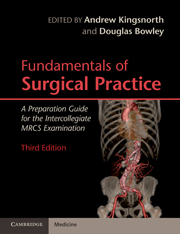Book contents
- Frontmatter
- Contents
- List of contributors
- Preface
- Section 1 Basic Sciences Relevant to Surgical Practice
- Section 2 Basic Surgical Skills
- Section 3 The Assessment and Management of the Surgical Patient
- 8 Preoperative assessment
- 9 Fundamentals of anaesthesia
- 10 Fundamentals of cancer management
- Section 4 Perioperative Care of the Surgical Patient
- Section 5 Common Surgical Conditions
- Index
- References
9 - Fundamentals of anaesthesia
Published online by Cambridge University Press: 03 May 2011
- Frontmatter
- Contents
- List of contributors
- Preface
- Section 1 Basic Sciences Relevant to Surgical Practice
- Section 2 Basic Surgical Skills
- Section 3 The Assessment and Management of the Surgical Patient
- 8 Preoperative assessment
- 9 Fundamentals of anaesthesia
- 10 Fundamentals of cancer management
- Section 4 Perioperative Care of the Surgical Patient
- Section 5 Common Surgical Conditions
- Index
- References
Summary
Anaesthesia may be defined as a pharmacologically induced state of reversible unconsciousness, during which the patient neither perceives nor recalls noxious stimuli. Anaesthetic drugs depress all excitable tissues and the central neurons are amongst the most sensitive. At sufficient anaesthetic depth conscious awareness and recall are lost, and normal sensory, somatic and autonomic responses to surgical stimulation are absent.
Anaesthesia is a non-therapeutic intervention, performed within a dedicated environment. The complications of anaesthesia may be poorly tolerated, so all patients must be individually assessed to evaluate the benefits versus potential risks. The maintenance of maximum perioperative safety is of significant importance during the administration of anaesthesia.
Stages of clinical anaesthesia
In 1937, four stages of progressively deeper anaesthesia were described by Guedel in unpremedicated patients during inhalational induction with diethyl ether. Modern advances have resulted in considerable changes to techniques and available drugs, so that the early stages of anaesthesia often occur too rapidly to be easily distinguished. The stages may be seen in reverse on emergence from anaesthesia.
Analgesia
In stage 1, inhalational sedation occurs prior to the loss of the eyelash reflex and unconsciousness.
Excitement
During stage 2, the breathing gradually becomes more irregular and airway irritability increases. The pupils become more dilated and uncontrolled limb movements may occur. The eyelid reflex is lost.
- Type
- Chapter
- Information
- Fundamentals of Surgical PracticeA Preparation Guide for the Intercollegiate MRCS Examination, pp. 134 - 150Publisher: Cambridge University PressPrint publication year: 2011



